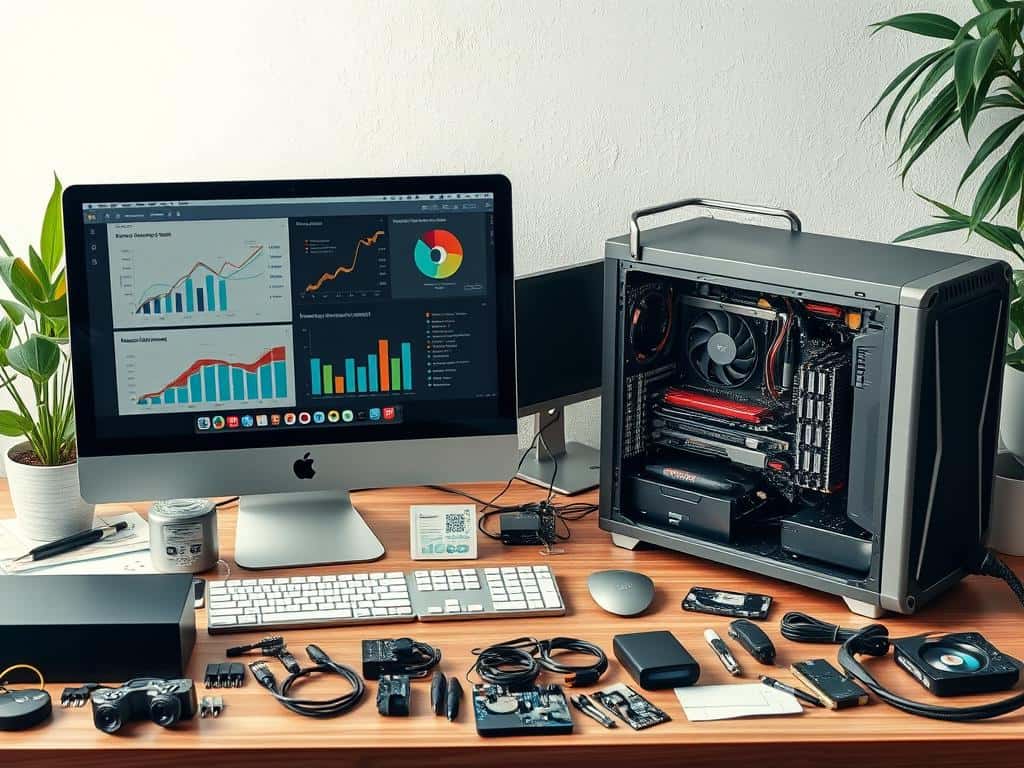Did you know a MacBook Air starts at around $1,000? But, you can get an entry-level PC for just $300 to $500? This big price gap is just the start of the debate between Macs and PCs. Knowing how macOS and Windows work is key to picking the right one for you.
In this guide, we’ll look at what makes each operating system special. You might choose a Mac for its design and creative tools. Or, you might pick a PC for its lower cost and more software options. Your decision will depend on what you need, like compatibility and user experience.
Key Takeaways
- The price gap between Macs and PCs varies greatly, with Macs generally starting higher.
- Macs have a minority market share, contributing to fewer viruses and less bloatware.
- PCs provide better backwards compatibility and hardware upgrade options.
- Macs are often preferred in creative industries, while PCs dominate in gaming.
- Understanding software compatibility is key when choosing between the two operating systems.
Understanding the Differences Between Operating Systems
When we compare macOS and Windows, we see many differences. Each system meets different user needs with its own set of features. Knowing these differences helps us choose the right one for us.
Overview of macOS and Windows
Apple’s macOS is known for being easy to use and simple. Its setup is designed to be quick and easy. On the other hand, Windows is great because it works with lots of different computers and lets users customize their setup. This makes Windows popular with many people.
Key Features of macOS
macOS has cool features like Gatekeeper, which keeps your computer safe from bad apps. It also works well with other Apple devices, like iPhones and iPads. This makes it a top choice for graphic designers and media editors, thanks to apps like iMovie and GarageBand.
Key Features of Windows
Windows is known for working with many different computers and software. It has lots of upgrade options, which is great for gamers and those who need more power. It also has new features like Windows Hello for safer sign-in and Snap Layouts for better multitasking.
Evaluating Your Needs: Mac vs PC
Choosing between a Mac and a Windows PC is a big decision. You need to think about cost, software, performance, and how easy it is to upgrade. These factors help decide which one is best for you.
Cost and Budget Considerations
Windows PCs are often cheaper, with prices from under $500 to over $2,000. Macs start at around $1,000. This price gap shows the quality and materials Apple uses.
While some PCs can cost as much as Macs, Windows is usually more affordable. This is great for those watching their budget.
Compatibility with Software and Devices
My choice might depend on what devices I already use. Macs work well with Apple products, making things easy and smooth. But, Windows PCs support more third-party software and devices.
This is important for businesses and gamers who need specific apps. Windows PCs often have what they need.
Performance for Specific Use Cases
For creative work, Macs are often the top choice. They handle graphics and workflows better. But, Windows PCs have more software options, which is good for gamers and some business needs.
What you do with your computer affects which one is better for you. It’s all about what you need it to do.
Upgradeability and Customization Options
Upgradeability is another key factor. Windows PCs are easy to upgrade, like adding more RAM or storage. This is perfect for those who like to tinker with their tech.
Mac upgrades are harder because many parts are soldered on. This limits what you can change later.

Conclusion
The debate between Mac vs PC is more than just a preference. It shows how different needs and professional demands play a role. Both operating systems have strengths for different users, whether for creative work, gaming, or everyday tasks.
Understanding macOS and Windows is key. Knowing my budget, software needs, and customization wants helps me choose wisely. This way, I can pick the best operating system for me.
In creative fields, many prefer Macs for their reliability with graphics software. Developers and financial analysts often choose PCs for their wide software range and cost. This shows that my choice should match my task needs.
By thinking about these points, I can find the right operating system. It should fit my tech and lifestyle needs perfectly.
In the end, choosing between operating systems is a personal decision. It should match my daily needs. Whether I pick a Mac or a PC, the most important thing is to have the tools I need to succeed.